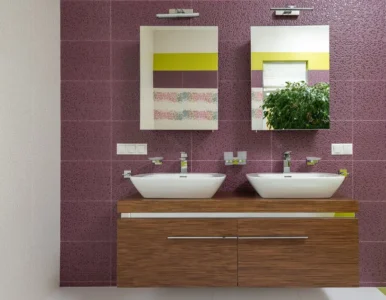Choosing the right tiles for your living room is a decision that goes beyond mere aesthetics. The type of tiles you choose can significantly influence the comfort, functionality, and overall appeal of your space. In this article, we’ll delve into the importance of selecting the perfect wall tiles, explore the factors to consider, review different types of tiles, discuss current trends, and finally, guide you on choosing the right tile for your living room.
Importance of Wall Tiles in a Living Room
- Wall tiles are not just functional elements; they play a crucial role in defining the aesthetics of your living room. The right choice of tiles can transform your space into a serene sanctuary, a vibrant meeting place, or a classy area for entertainment. Think of them as the canvas upon which your furniture, accessories, and lighting become a captivating painting.
- Beyond aesthetics, wall tiles play a practical role as well. They are known for their durability, resistance to stains, and easy-to-clean features – all while retaining their original charm for years.
- Therefore, when choosing tiles, you need to consider your living room’s overall design scheme. The tiles should blend seamlessly with your decor and accentuate the style you aim for.
Factors to Consider When Choosing Tiles
- Durability: High-traffic living rooms need tiles that can withstand wear and tear. Porcelain and ceramic tiles are often popular choices due to their durability.
- Maintenance: Some tiles require more care than others. For instance, natural stone tiles need regular sealing to prevent staining.
- Cost: Budget is an important consideration. Keep in mind that aside from the tiles’ cost, you will also need to consider installation expenses.
- Color and design: This is where aesthetics come into play. You could opt for a timeless look with neutral colors, or make a bold statement with vibrant shades and unique patterns.
- Size and shape: The size and shape of the tiles can significantly affect your living room’s look. Larger tiles can make a room appear more spacious, while smaller tiles can add a cozy feel.
- Texture: This impacts both the look and feel of the room. Rough textures can add a rustic appeal, while smooth tiles lend a modern, sleek vibe.
- Installation process: Some tiles are easier to install than others. Consider professional installation for complex tile designs or materials.
Review of Different Types of Tiles
Ceramic Tiles
Ceramic tiles, made from clay and fired at high temperatures, are a popular choice for many homeowners due to their versatility and cost-effectiveness.
- Pros: They’re available in a wide range of colors, patterns, and textures. These tiles are resistant to stains and water absorption, making them easy to clean and maintain. Their durability withstands daily wear and tear.
- Cons: Although sturdy, ceramic tiles can chip or crack under heavy impact or if a heavy object is dropped on them. They also tend to be colder underfoot, which might not be ideal in colder climates unless installed with a radiant heating system.
- Best uses: Due to their versatility and wide range of designs, ceramic tiles are suitable for various living room styles, from casual and comfortable to more formal settings.
Porcelain Tiles:
Porcelain tiles are a subtype of ceramic tiles, made from more refined clay and fired at higher temperatures, making them denser and more durable.
- Pros: Porcelain tiles are exceptionally robust and moisture-resistant. They’re less prone to staining and can withstand high traffic better than ceramic tiles.
- Cons: Due to their density, porcelain tiles are more challenging to cut and install, which might increase installation costs. They are also generally more expensive than other tile types.
- Best uses: The durability and high-end look of porcelain tiles make them suitable for luxurious, elegant, and high-traffic living rooms.
Marble Tiles
Marble tiles are a timeless choice that adds a touch of elegance and sophistication to any room.
- Pros: As a natural stone, each marble tile is unique, with beautiful veining and variations. Marble can also increase your property’s value due to its high-end appeal.
- Cons: Marble requires regular sealing and maintenance to prevent stains and scratches, as it is relatively soft for a stone. Polished marble can be slippery, posing a potential safety hazard.
- Best uses: Marble tiles are perfect for creating a luxurious, elegant living room, especially when aiming for a classic or contemporary design.
Glass Tiles
Glass tiles are a modern option that can bring a unique, light-reflective quality to your living room.
- Pros: They can brighten up any room by reflecting light, making the room appear larger and more open. Glass tiles are also resistant to stains, mold, and mildew.
- Cons: Despite their aesthetic appeal, glass tiles can be quite expensive. They are also more susceptible to scratches and can chip on the edges if not properly installed.
- Best uses: Glass tiles are ideal for creating a focal point in your living room or as accent pieces on walls due to their reflective qualities. They’re also suitable for smaller living rooms where you’d want to create a sense of space.
Granite Tiles
A type of igneous rock, granite is one of the hardest substances on earth, making it an exceptionally durable choice for tiles.
- Pros: It boasts a range of natural patterns and is highly resistant to scratches and stains.
- Cons: Granite requires regular sealing to keep it looking its best and to prevent it from absorbing liquids.
- Best uses: Ideal for high-traffic living rooms where durability is a priority without sacrificing aesthetic appeal.
Limestone Tiles
Composed mainly of calcium carbonate, limestone tiles offer a natural, rustic look.
- Pros: Its warm, earthy tones, and the natural variation in texture and color can add an old-world charm to your living room.
- Cons: Being porous, it’s prone to stains unless sealed properly and regularly. Limestone is also softer than other stones, making it susceptible to scratches.
- Best uses: Perfect for those aiming for a rustic, country-style living room.
Popular Living Room Wall Tile Designs and Trends
Today, living room wall tile designs are increasingly becoming daring and unconventional. Large-format tiles are trending, as they create a seamless and spacious look. Additionally, the mix and match trend of different tile sizes and shapes is also popular. For a standout feature, 3D tiles that bring depth and texture are being widely used.
How to Choose the Right Tile for Your Living Room
- Ensure the tiles match your overall living room design. If you have a minimalist decor, consider large, monochrome tiles. For a rustic charm, stone tiles might be the way to go.
- Striking a balance between aesthetics and practical considerations is important. For example, a marble floor might look gorgeous, but it’s not the best if you have kids running around.
Conclusion
In conclusion, choosing the right tiles can make or break your living room design. It’s a blend of the perfect aesthetic appeal, practicality, durability, and maintenance requirements. As you choose your living room tiles, always consider your lifestyle, budget, and overall decor theme. It might seem like a daunting task, but with the right approach, you’ll have a living room that not only looks beautiful but also serves your needs perfectly.
Frequently Asked Questions (FAQs)
What’s the most durable type of tile for a living room?
Porcelain tiles are often considered the most durable due to their high resistance to scratches, stains, and water. However, ceramic and stone tiles are also quite durable if properly maintained.
Can I use different types of tiles in my living room?
Absolutely. Mixing different types of tiles can add an interesting visual dynamic to your living room. You can use one type as the main tile and another as an accent. Just make sure they complement each other and the overall aesthetic of your living room.
Do all tiles require professional installation?
Not necessarily. Certain types of tiles, such as peel-and-stick tiles, are relatively easy to install yourself. However, for larger, heavier, or more intricate tiles, professional installation is recommended to ensure they’re properly and securely installed.
How often should I clean my tiles?
The frequency of cleaning depends on the type of tile and the amount of foot traffic your living room sees. Generally, tiles should be swept or vacuumed weekly to remove dirt and dust, and mopped every two weeks. However, high-traffic areas might require more frequent cleaning.
How can I make my small living room look larger with tiles?
You can create the illusion of a larger space by using large-format tiles with a light color. Also, using tiles with a glossy finish can reflect light, making the room feel brighter and more spacious.
What’s the best way to maintain natural stone tiles?
Natural stone tiles should be sealed upon installation and resealed every 1-2 years. Avoid acidic or abrasive cleaners, opting instead for a pH-neutral cleaner designed for stone. Spills should be wiped up promptly to prevent staining.





